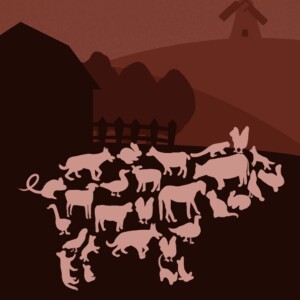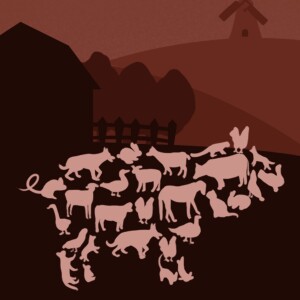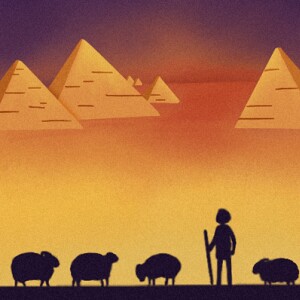Episodes

Wednesday Jul 05, 2023
Wednesday Jul 05, 2023
Capítulo 1:¿Qué es Rebelión en la Granja acerca de
Rebelión en la Granja es una novela alegórica escrita por George Orwell. Narra la historia de un grupo de animales de Rebelión en la Granja que se rebelan contra su granjero humano para establecer una sociedad igualitaria y justa. Los animales están liderados por dos cerdos, Bola de Nieve y Napoleón, que al principio trabajan juntos para planear y ejecutar la revolución. Crean un conjunto de siete mandamientos conocido como Animalismo, que refleja los principios idealistas de igualdad y cooperación.
Sin embargo, con el tiempo, Napoleón se hace con el poder y manipula los acontecimientos para consolidar su autoridad. Poco a poco se convierte en un líder tiránico, que cambia los principios originales para beneficiarse a sí mismo y a los demás cerdos, mientras explota al resto de los animales. Los mandamientos se revisan, los objetivos originales se abandonan y los cerdos se vuelven indistinguibles de sus antiguos opresores humanos.
A través de su retrato satírico de la Revolución rusa de 1917 y la posterior era estalinista, Rebelión en la Granja explora temas como el totalitarismo, la corrupción del poder, la propaganda y los peligros de la lealtad ciega. Sirve como crítica de los sistemas políticos y del potencial de los líderes para abusar de sus posiciones, destacando en última instancia la traición de los ideales originales y la pérdida de la libertad.
La lucha de los animales por su emancipación y la posterior corrupción de su revolución sirven como lecciones intemporales sobre las complejidades del poder, el liderazgo y la importancia de una vigilancia constante para preservar los valores democráticos.
Capítulo 2:Autor de la Rebelión en la Granja Animal
El autor de la célebre novela "Rebelión en la Granja" es George Orwell. Publicada en 1945, "Rebelión en la Granja" es una alegoría política que utiliza a los animales de una Rebelión en la Granja para representar los acontecimientos que condujeron a la Revolución Rusa y a la posterior Unión Soviética. George Orwell, cuyo verdadero nombre era Eric Arthur Blair, fue un escritor inglés conocido por sus obras que invitan a la reflexión y que a menudo critican el totalitarismo y exploran temas políticos. A través de "Rebelión en la Granja", Orwell ofrece una poderosa crítica del autoritarismo y de los peligros de que el poder corrompa a individuos e instituciones.
Capítulo 3:Libros similares a Rebelión en la Granja
"1984", de George Orwell: Este clásico distópico también escrito por George Orwell explora una sociedad totalitaria gobernada por el Gran Hermano. Aborda temas como la vigilancia, la manipulación y la supresión de la individualidad.
"Un mundo feliz", de Aldous Huxley: Ambientada en un mundo futuro en el que la ingeniería genética y el consumo masivo controlan la sociedad, esta novela describe un futuro altamente controlado y aparentemente utópico. Plantea cuestiones sobre el precio de la felicidad y la pérdida de individualidad.
"Fahrenheit 451", de Ray Bradbury: En esta obra de ficción especulativa, los libros están prohibidos y los bomberos los queman para mantener el orden social. La historia sigue a un bombero que empieza a cuestionarse su papel y explora temas como la censura, la libertad intelectual y el poder del conocimiento.
"El señor de las moscas", de William Golding: Esta novela alegórica retrata a un grupo de escolares varados en una isla deshabitada que se sumen en el caos y la violencia. Explora la capacidad innata del ser humano para el mal y el desmoronamiento de la civilización.
"El cuento de la criada", de Margaret Atwood: Este libro, que transcurre en un futuro distópico cercano, describe una sociedad en la que las mujeres están sometidas a una estricta opresión y control reproductivo. Plantea cuestiones de desigualdad de género, dinámicas de poder y las consecuencias de los regímenes autoritarios.
"Nosotros" de Yevgeny Zamyatin: Escrita antes que "1984" y "Un mundo feliz", esta novela explora una sociedad futurista en la que no existe la libertad personal y se impone la conformidad. Destaca la lucha entre individualismo y colectivismo.
"El dador", de Lois Lowry: Dirigida a jóvenes adultos, esta novela presenta una sociedad aparentemente perfecta carente de dolor, sufrimiento y emociones. A medida que la protagonista va conociendo las verdades ocultas que se esconden tras esta sociedad, surgen preguntas sobre la conformidad, la individualidad y el valor de los recuerdos.

Tuesday Jul 04, 2023
Tuesday Jul 04, 2023
Chapter 1:What's Millionaire Next Door about
It explores the lifestyle and habits of America's wealthy individuals, particularly those who have accumulated wealth on their own rather than inheriting it.
The central premise of the book is that many millionaires do not fit the common stereotype of extravagant spending and luxurious lifestyles. Instead, they live modestly, make frugal choices, and save diligently. The authors argue that true wealth is often hidden beneath the surface in the form of financial independence, rather than being displayed through material possessions.
The book delves into various characteristics and behaviors exhibited by these self-made millionaires. It emphasizes concepts like living below your means, saving and investing consistently, avoiding conspicuous consumption, and prioritizing financial independence over social status. It also discusses the importance of education, career choices, and entrepreneurship as means to accumulate wealth.
Through extensive research and case studies, the authors challenge common misconceptions about wealth and provide insights into the mindset and habits of millionaires. They aim to inspire readers to adopt similar financial practices and attain financial independence, regardless of their income level or occupation.
Chapter 2:Author of the Millionaire Next Door
The author of "The Millionaire Next Door" is Thomas J. Stanley, along with William D. Danko. This book was published in 1996 and became a bestseller. It explores the characteristics and habits of wealthy individuals in America, debunking many common misconceptions about wealth and highlighting the importance of frugality, hard work, and financial discipline. The authors conducted extensive research and interviews to uncover the secrets behind true financial success, challenging the notion that millionaires are typically living luxurious lifestyles. Instead, they argue that most wealthy individuals live modestly, make wise financial decisions, and prioritize long-term wealth accumulation over immediate gratification.
Chapter 3:Similar Books like Millionaire Next Door
"Rich Dad Poor Dad" by Robert Kiyosaki: This book emphasizes financial education and challenges traditional thinking about money. It offers insights into building wealth through real estate investments and entrepreneurship.
"The Richest Man in Babylon" by George S. Clason: Set in ancient Babylon, this book presents timeless principles of wealth creation and financial management through simple parables. It provides practical advice on saving, investing, and growing your wealth.
"Think and Grow Rich" by Napoleon Hill: This classic self-help book investigates the mindset and strategies of successful individuals. It explores the power of positive thinking and goal setting to achieve financial success.
"The Automatic Millionaire" by David Bach: Focusing on the importance of automating your finances, this book guides readers on how to build wealth by setting up automated systems for saving, investing, and debt repayment.

Monday Jul 03, 2023
Monday Jul 03, 2023
Chapter 1:What's Animal Farm about
Animal Farm is an allegorical novella written by George Orwell. It tells the story of a group of farm animals who rebel against their human farmer in order to establish an equal and just society. The animals are led by two pigs, Snowball and Napoleon, who initially work together to plan and execute the revolution. They create a set of seven commandments known as Animalism, which reflects the idealistic principles of equality and cooperation.
However, over time, Napoleon seizes power and manipulates events to consolidate his authority. He gradually becomes a tyrannical leader, changing the original principles to benefit himself and the other pigs, while exploiting the rest of the animals. The commandments are revised, the original goals are abandoned, and the pigs become indistinguishable from their former human oppressors.
Through its satirical portrayal of the Russian Revolution of 1917 and subsequent Stalinist era, Animal Farm explores themes such as totalitarianism, corruption of power, propaganda, and the dangers of blind loyalty. It serves as a critique of political systems and the potential for leaders to abuse their positions, ultimately highlighting the betrayal of the original ideals and the loss of freedom.
The animals' struggle for emancipation and the subsequent corruption of their revolution serve as timeless lessons about the complexities of power, leadership, and the importance of constant vigilance in preserving democratic values.
Chapter 2:Author of the Animal Farm
The author of the renowned novella "Animal Farm" is George Orwell. Published in 1945, "Animal Farm" is a political allegory that uses animals on a farm to represent the events leading up to the Russian Revolution and the subsequent Soviet Union. George Orwell, whose real name was Eric Arthur Blair, was an English writer known for his thought-provoking works that often critiqued totalitarianism and explored political themes. Through "Animal Farm," Orwell provides a powerful critique of authoritarianism and the dangers of power corrupting individuals and institutions.
Chapter 3:Similar Books like Animal Farm
"1984" by George Orwell: This dystopian classic also written by George Orwell explores a totalitarian society ruled by Big Brother. It delves into themes of surveillance, manipulation, and the suppression of individuality.
"Brave New World" by Aldous Huxley: Set in a future world where genetic engineering and mass consumption control society, this novel depicts a highly controlled and seemingly utopian future. It raises questions about the price of happiness and the loss of individuality.
"Fahrenheit 451" by Ray Bradbury: In this speculative fiction work, books are banned, and firemen burn them to maintain societal order. The story follows a fireman who begins questioning his role and explores themes of censorship, intellectual freedom, and the power of knowledge.
"Lord of the Flies" by William Golding: This allegorical novel portrays a group of schoolboys stranded on an uninhabited island who descend into chaos and violence. It explores the innate human capacity for evil and the breakdown of civilization.
"The Handmaid's Tale" by Margaret Atwood: Taking place in a dystopian near-future, this book depicts a society where women are subjected to strict oppression and reproductive control. It raises issues of gender inequality, power dynamics, and the consequences of authoritarian regimes.
"We" by Yevgeny Zamyatin: Written before both "1984" and "Brave New World," this novel explores a futuristic society where personal freedom is nonexistent, and conformity is enforced. It highlights the struggle between individualism and collectivism.
"The Giver" by Lois Lowry: Targeted towards young adults, this novel presents a seemingly perfect society devoid of pain, suffering, and emotions. As the protagonist learns about the hidden truths behind this society, questions of conformity, individuality, and the value of memories arise.

Friday Jun 30, 2023
Friday Jun 30, 2023
Capítulo 1:El Alquimista ¿por qué clásico?
Temas universales: La novela aborda temas universales como el destino, la búsqueda de la felicidad, el propósito de la vida y el poder de los sueños. Estos temas trascienden el tiempo y el espacio, lo que hace que la historia sea relevante para lectores de diferentes épocas y culturas.
Simplicidad y profundidad: Aunque "El alquimista" es una novela corta y de fácil lectura, contiene una profunda reflexión sobre la existencia humana. El lenguaje sencillo y directo de Paulo Coelho permite que los lectores se conecten con los personajes y absorban las enseñanzas filosóficas presentes en la historia.
Inspiración y motivación: La obra transmite un mensaje positivo y motivador sobre seguir los propios sueños y escuchar la voz interior. Muchos lectores han encontrado inspiración en la historia del joven pastor Santiago, quien emprende un viaje en busca de su tesoro personal y descubre valiosas lecciones a lo largo del camino.
Éxito y reconocimiento mundial: Desde su publicación en 1988, "El alquimista" ha vendido millones de copias en todo el mundo y ha sido traducido a numerosos idiomas. Este éxito y la resonancia duradera que ha tenido entre los lectores lo han convertido en un clásico moderno.
En resumen, "El alquimista" es considerado un clásico debido a sus temas universales, su capacidad para transmitir mensajes profundos de manera accesible, su inspiración y motivación, así como su éxito y reconocimiento a nivel mundial.
Capítulo 2: Resumen de El alquimista
"El alquimista" es una novela escrita por el autor brasileño Paulo Coelho. Publicada en 1988, la historia sigue los pasos de Santiago, un joven pastor que decide abandonar su vida cómoda y viajar en busca de un tesoro oculto en las Pirámides de Egipto, después de tener un sueño recurrente.
Durante su viaje, Santiago se encuentra con diferentes personajes que le enseñan valiosas lecciones sobre el destino, el amor y el propósito en la vida. Uno de estos personajes es Melquisedec, el rey de Salem, quien le habla sobre la importancia de seguir los sueños y escuchar al corazón.
Más adelante, Santiago llega a un oasis en el desierto, donde conoce a la hermosa Fátima y al Alquimista, quienes lo ayudan a entender que el verdadero tesoro no está en las riquezas materiales, sino en descubrir su propia leyenda personal y cumplir su destino.
A medida que avanza en su viaje, Santiago aprende a confiar en sí mismo y en las señales del universo. Descubre que el lenguaje de los omens, o signos, puede guiarlo hacia su objetivo. A través de la filosofía de la "Leyenda Personal", Santiago aprende a escuchar a su corazón y a conectarse con el "Alma del Mundo".
Finalmente, Santiago logra encontrar el tesoro que buscaba, pero no en la forma esperada. A través de esta experiencia, aprende que el verdadero valor radica en el viaje en sí mismo, en la superación de obstáculos y en el aprendizaje a lo largo del camino.
"El alquimista" es una historia inspiradora que invita a los lectores a reflexionar sobre sus propios sueños y a seguir su propio camino en la vida. A través de metáforas y enseñanzas espirituales, Coelho transmite mensajes sobre el poder de la fe, la importancia de escuchar nuestro corazón y la búsqueda de nuestro propósito personal.
Capítulo 3:El Alquimista Significado
"El Alquimista" es una novela escrita por Paulo Coelho que fue publicada por primera vez en 1988. La historia sigue a Santiago, un joven pastor español que decide emprender un viaje en busca de su "leyenda personal", su propósito en la vida. Durante su travesía, se encuentra con varios personajes y situaciones que lo desafían y lo ayudan a descubrir su verdadero potencial.
El título de la novela, "El Alquimista", tiene un significado simbólico importante. La alquimia es una antigua práctica filosófica y mística que buscaba transformar metales comunes en oro, así como descubrir el elixir de la vida eterna. En el contexto de la novela, el término "alquimista" representa a alguien que tiene conocimientos profundos y habilidades especiales para entender los secretos del universo y la naturaleza humana.
A lo largo de la historia, Santiago aprende lecciones valiosas sobre la importancia de seguir sus sueños, confiar en sí mismo y escuchar su corazón. El viaje del protagonista es una metáfora de la búsqueda interior que todos enfrentamos en algún momento de nuestras vidas.
En última instancia, el significado de "El Alquimista" radica en la idea de que cada persona tiene un propósito único en la vida y que si seguimos nuestros corazones y estamos dispuestos a tomar riesgos, podemos encontrar la felicidad y cumplir nuestros sueños más profundos. La novela nos recuerda la importancia de conectarnos con nuestra propia esencia y explorar nuestro potencial ilimitado.

Friday Jun 30, 2023
Friday Jun 30, 2023
Capítulo 1:¿El viejo y el mar un clásico?
"El viejo y el mar" es considerado un clásico de la literatura. Fue escrito por Ernest Hemingway y publicado en 1952. La novela cuenta la historia de Santiago, un viejo pescador cubano, y su lucha épica contra un gran pez en el mar. A través de su narración sencilla pero poderosa, Hemingway aborda temas como la resistencia, la perseverancia y la naturaleza humana. "El viejo y el mar" ha sido elogiado por su estilo conciso y su profunda exploración de la condición humana, convirtiéndose en una obra icónica de la literatura del siglo XX y un clásico indiscutible.
Capítulo 2: El protagonista de El viejo y el mar
El protagonista de la novela "El viejo y el mar" es un pescador llamado Santiago. La historia escrita por Ernest Hemingway se centra en la vida de este personaje solitario y perseverante, que se embarca en una lucha épica contra un pez gigante en las aguas del Golfo de México.
Santiago es retratado como un hombre mayor, experimentado y sabio, que ha pasado numerosos días sin tener éxito en sus expediciones de pesca. A pesar de su mala racha, conserva su determinación y no se rinde fácilmente.
Durante su última travesía, Santiago atrapa un enorme pez espada, al que llama "el gran marlín". Esta captura desencadena una intensa batalla entre el hombre y la bestia, que simboliza la lucha del individuo contra los desafíos de la vida. A medida que Santiago lucha por mantenerse firme ante la fuerza del pez y las adversidades del océano, demuestra su coraje, tenacidad y resiliencia.
A lo largo de la historia, Santiago enfrenta tanto elementos físicos como mentales, y se convierte en un símbolo de la perseverancia humana frente a la derrota. Aunque al final el pez es devorado por los tiburones, Santiago regresa a tierra con la cabeza erguida, sabiendo que ha demostrado su valía como pescador y como ser humano.
"El viejo y el mar" es considerada una obra maestra de la literatura y ha sido aclamada por su profundidad temática y estilo conciso y directo. La figura de Santiago encarna muchos de los valores y luchas universales del ser humano, convirtiéndolo en un protagonista memorable.
Capítulo 3: Cómo Termina El viejo y el mar
El viejo y el mar, escrito por Ernest Hemingway, termina con una mezcla de esperanza y resignación. Tras una larga y agotadora lucha, el pescador Santiago logra atrapar un enorme pez espada en alta mar. Sin embargo, durante su regreso a la costa, su presa es devorada por los tiburones.
A medida que los tiburones se acercan, Santiago se da cuenta de que ha perdido su valiosa captura y sufre una gran desilusión. A pesar de esto, se mantiene firme y lucha contra los tiburones con determinación, utilizando su astucia y sus habilidades para defenderse.
Finalmente, el viejo llega a la orilla, exhausto pero sin rendirse. Aunque ha perdido su preciado pez, ha demostrado su coraje y resistencia. Al llegar al puerto, el pueblo queda impresionado por el tamaño del esqueleto del pez espada que quedó amarrado al bote.
La historia concluye con Santiago durmiendo profundamente en su cama, soñando con leones en la playa de su juventud, lo cual simboliza la renovación y la vida que aún le queda. A pesar de su derrota aparente, el viejo ha encontrado una especie de triunfo interior y perseverancia frente a las adversidades.
En resumen, El viejo y el mar termina con una nota agridulce: aunque Santiago perdió su captura, demostró su tenacidad y se aferró a su dignidad, dejando una lección sobre cómo enfrentar los desafíos de la vida con valentía y resolución.

Friday Jun 30, 2023
Friday Jun 30, 2023
Capítulo 1:De Qué Trata El Libro El Club de las 5 de la mañana
El libro "El Club de las 5 de la mañana" es escrito por Robin Sharma, un autor y conferencista reconocido en el ámbito del desarrollo personal y profesional. El tema principal del libro gira en torno a la importancia de tener una rutina matutina efectiva para mejorar nuestra productividad y alcanzar el éxito.
En la obra, Sharma presenta cinco prácticas fundamentales que propone realizar cada mañana antes de las 5 a.m., las cuales son:
Despertar a las 5 de la mañana: Se enfatiza la importancia de levantarse temprano para aprovechar las primeras horas del día con calma y dedicación.
Ejercicio físico: Promueve la práctica de actividad física regular para incrementar los niveles de energía y bienestar físico.
Meditación: Propone la meditación como una forma de cultivar el enfoque mental, reducir el estrés y encontrar claridad en nuestros objetivos.
Planificación del día: Destaca la importancia de establecer metas claras y diseñar un plan estratégico para alcanzarlas.
Aprendizaje y crecimiento: Sugiere dedicar tiempo a la lectura y al aprendizaje continuo para expandir nuestro conocimiento y desarrollar nuevas habilidades.
A través de consejos prácticos y anécdotas inspiradoras, Sharma busca proveer herramientas para que las personas adopten hábitos positivos y aprovechen al máximo sus mañanas, lo cual puede tener un impacto significativo en su vida personal y profesional. El libro invita al lector a reflexionar sobre su propio estilo de vida y a implementar cambios que le permitan alcanzar una mayor productividad y bienestar general.
Capítulo 2:Escritor De El Club de las 5 de la mañana
Robin Sharma es un autor muy respetado en el ámbito del desarrollo personal y el liderazgo. Sus libros, como "El monje que vendió su Ferrari", "El líder que no tenía título" y "El club de las 5 de la mañana", han sido ampliamente aclamados por brindar valiosas lecciones y estrategias prácticas para alcanzar el éxito en todas las áreas de la vida.
Lo que distingue a Robin Sharma es su énfasis en la importancia de la disciplina, los hábitos diarios y una mentalidad positiva. Él cree firmemente en la capacidad de cada individuo para obtener éxito y encontrar significado en su vida. Sus enseñanzas incorporan elementos de la filosofía oriental y la espiritualidad, promoviendo la atención plena y la paz interior como herramientas para el crecimiento personal.
Además de sus libros, Robin Sharma es conocido por sus conferencias motivacionales. A través de sus discursos inspiradores, comparte sus ideas sobre el liderazgo efectivo, el rendimiento máximo y cómo crear una vida plena y significativa. Su estilo de comunicación claro y directo ha resonado con personas de diferentes culturas y ha dejado una huella duradera en aquellos que buscan alcanzar su máximo potencial.
En resumen, Robin Sharma es un experto en liderazgo y desarrollo personal cuyos libros y conferencias han tenido un impacto significativo en la forma en que las personas abordan la vida y el trabajo. Sus enseñanzas fomentan la responsabilidad personal, la aceptación del cambio y la búsqueda de la excelencia a través de hábitos diarios consistentes.
Capítulo 3:Libros Similares a El Club De Las 5 De La Mañana
"El monje que vendió su Ferrari" por Robin Sharma: Este libro también aborda temas de superación personal y desarrollo personal. Narra la historia de un exitoso abogado que decide abandonar su carrera en busca de una vida más significativa y equilibrada.
"El poder del ahora" por Eckhart Tolle: En este libro, Tolle explora el concepto de vivir en el presente y cómo esto puede transformar nuestra vida. Proporciona técnicas prácticas para alejarse del pensamiento negativo y encontrar la paz interior.
"El arte de no amargarse la vida" por Rafael Santandreu: Este libro ofrece herramientas y estrategias para manejar el estrés y la adversidad, promoviendo una actitud de resiliencia y bienestar emocional.
"Despierta tu héroe interior" por Victor Kuppers: En esta obra, Kuppers nos invita a reflexionar sobre nuestras metas y sueños, animándonos a tomar acción y desarrollar nuestro potencial personal.
"El poder de los hábitos" por Charles Duhigg: Duhigg explora cómo los hábitos influyen en nuestras vidas y cómo podemos cambiarlos para lograr nuestros objetivos. Presenta investigaciones científicas y ejemplos prácticos para entender cómo funcionan los hábitos y cómo modificarlos.

Friday Jun 30, 2023
Friday Jun 30, 2023
Capítulo 1: ¿Dónde Nacidos Para Correr
Nacidos Para Correr, escrito por Trevor Noah, tiene lugar principalmente en Sudáfrica. El libro proporciona un relato detallado de la infancia y adolescencia de Trevor Noah en varios barrios de johannes, la ciudad más grande de Sudáfrica. Explora las complejide crecer como un niño de raza mixta durante los últimos años del apartheid y la tumultuosa transición que siguió. La historia se adentra en la dinámica cultural y social única de Sudáfrica, que influenormemente en la educación de Trevor Noah.
Capítulo 2: los Thems Of a Book Nacidos Para Correr
Los temas explorados en el libro "Nacidos Para Correr" de Trevor Noah son los siguientes:
Racial Identity and Apartheid: el libro profundien las experiencias de Trevor Noah creciendo como un niño de raza mixta en la Sudáfrica del Apartheid, donde su existencia era considerada ilegal bajo las leyes del régimen. El tema de la identidad racial es central en la narrativa, mientras Noah navpor los desafíos, prejuicios y complejiasociados con "haber nacido como un crimen".
Familia y pertenencia: a lo largo del libro, Noah explora el significado de la familia y cómo da forma a su sentido de pertenencia. Comparte anécdotas sobre su madre, quien jugó un papel fundamental en su vida, y otros miembros de la familia que lo apoyaron durante momentos difíciles. El tema subraya la importancia de los lazos familiares y el amor incondicional.
Resiliy supervivencia: "Nacidos Para Correr" retrata la resistencia y capacidad de Noah para adaptarse a circunstancias difíciles. Desde sus encuentros infantiles con la violencia, la pobreza y el racismo hasta sus luchas con la identidad, demuestra una notable resistencia para superar estos obstáculos y forjar su propio camino.
Humor y sátira: como comediy presentde televisión, Noah infunhumor y sátira en todo el libro. Su perspectiva cómica no sólo proporciona lige, sino que también sirve como una herramienta para analizar los problemas sociales, arrojluz sobre los absure injusticias que experimentó.
Educación y empoderamiento: la educación juega un papel significativo en el viaje de Noé. A pesar de enfrentar numerosas barreras, enfatiza el poder transformador de la educación, destacando su capacidad para proporcionar conocimiento, crear oportunidades y empodera a las personas para desafiar el status quo.
Love and Relationships: Noah reflexisobre varias relaciones en su vida, explorando la dinámica entre amigos, parejas románticas y mentores. Estas historias subrayla importancia de las conexiones genu, la confianza y el impacto que tienen en el crecimiento personal.
Prejuicio y racismo: el libro examina la naturaleza penetrante del prejuicio y el racismo dentro de la sociedad sudafricana. Las experiencias de Noah ilustran los efectos perjudiciales de la discriminación sistémica, a la vez que arrojan luz sobre su viaje personal hacia la empatía y la comprensión.
Desigualdad Social y pobreza: "Nacidos Para Correr" también explora temas de desigualdad Social y pobreza. Noah comparte vívidos relatos de las disparidades que presencial crecer, destacando las luchas que enfrentan las comunidades marginadas y el impacto de los factores socioeconómicos en las vidas de las personas.
Capítulo 3: ¿Cuántos capítulos en el Nacidos Para Correr
"The Nacidos Para Correr" de Trevor Noah no tiene capítulos tradicionales. En su lugar, se compone de varios cuentos o anécdotas que componen el libro. Estas historias no están numeradas o divididas en capítulos. El libro está organizado temáticamente, explorando diferentes aspectos de la vida de Trevor Noah creciendo en Sudáfrica durante el apartheid y los desafíos que enfrentó como un niño mestizo.

Friday Jun 30, 2023
Friday Jun 30, 2023
Capítulo 1: Por Qué El Principito Merece La Pena Leer
Mensajes universales: El Principito aborda temas profundos y universales como el amor, la amistad, la soledad, la importancia de apreciar las cosas simples de la vida y la necesidad de cuidar nuestro entorno. Estos mensajes atemporales hacen que la historia sea relevante para personas de todas las edades y culturas.
Narrativa poética: La forma en que está escrito el libro es muy poética y evocadora. Antoine de Saint-Exupéry utiliza un lenguaje sencillo pero lleno de metáforas y simbolismos que invitan a la reflexión. Esta narrativa única hace que la lectura sea una experiencia emotiva y memorable.
Personajes entrañables: El Principito y los personajes que encuentra en su viaje son tiernos y llenos de personalidad. Cada uno tiene algo especial que enseñar al lector, ya sea el zorro con su lección sobre la amistad o el rey con su reflexión sobre el poder y la responsabilidad. Estos personajes se quedan en la memoria del lector mucho después de terminar el libro.
Fantasía y realidad: Aunque El Principito es un libro catalogado como literatura infantil, su mensaje trasciende las edades. Combina elementos de fantasía con situaciones y emociones reales que todos podemos experimentar. Esta mezcla de realidad y fantasía nos ayuda a reflexionar sobre nuestras propias vidas y a mirar el mundo desde una perspectiva más amplia.
En resumen, El Principito es una obra maestra de la literatura que merece la pena leer por su profundidad, su estilo poético, sus personajes entrañables y su capacidad para inspirar y enseñar. A través de esta historia, Antoine de Saint-Exupéry nos invita a reflexionar sobre lo que realmente importa en la vida y a encontrar el valor de las cosas simples y esenciales.
Capítulo 2: Lo Que El Zorro Significa Para El Principito
En la obra "El principito" de Antoine de Saint-Exupéry, el zorro juega un papel importante en la vida del protagonista. Aunque es un personaje secundario, el zorro representa varios conceptos simbólicos para el principito. Aquí hay algunos significados que se le atribuyen:
Amistad y conexión: El zorro enseña al principito sobre la importancia de establecer vínculos afectivos y desarrollar amistades significativas. A través de su relación con el zorro, el principito aprende a valorar la compañía y el compromiso emocional.
Domesticación: El proceso de domesticar al zorro es una metáfora de cómo las relaciones humanas requieren tiempo, paciencia y dedicación. Al principio, el zorro es indiferente al principito, pero a medida que pasan tiempo juntos, se establece un lazo especial entre ellos.
Responsabilidad y cuidado: El zorro le explica al principito que al domesticarlo, se convierte en único para él. Esto implica que asume la responsabilidad de cuidar y proteger lo que ha sido domesticado. De esta forma, el zorro le enseña al principito sobre el valor de la responsabilidad y el compromiso hacia los demás.
Ver más allá de las apariencias: El zorro le dice al principito que solo se puede ver correctamente con el corazón, no con los ojos. Esta idea refuerza el mensaje de la obra, destacando la importancia de mirar más allá de las apariencias superficiales y conectar con las verdaderas cualidades y características internas de las personas.
En resumen, el zorro en "El principito" representa la amistad, la conexión emocional, el cuidado y la responsabilidad, así como la idea de mirar más allá de las apariencias para comprender el verdadero valor de las personas.
Capítulo 3: El Principito Cita
"Lo esencial es invisible a los ojos." Esta frase hace referencia a la importancia de lo que no se puede ver a simple vista, como los sentimientos y las relaciones humanas.
"Solo se ve bien con el corazón; lo esencial es invisible a los ojos." Esta cita profundiza en la idea anterior, enfatizando que la verdadera belleza radica en la conexión emocional y no en la apariencia física.
"Todas las personas mayores fueron al principio niños, aunque pocas de ellas lo recuerdan." El Principito reflexiona sobre cómo la mayoría de los adultos han perdido su sentido de asombro y espontaneidad de la infancia, lo cual es una llamada a preservar nuestra capacidad de maravillarnos.
"Si vienes, por ejemplo, a las cuatro de la tarde, comenzaré a ser feliz desde las tres." Esta frase muestra la importancia de la anticipación y la ilusión en la felicidad, enfatizando cómo incluso esperar algo puede generar alegría.
"Adiós -dijo el zorro-. He aquí mi secreto, que no puede ser más simple: solo con el corazón se puede ver bien; lo esencial es invisible para los ojos." Esta cita resume uno de los mensajes centrales del libro, destacando la importancia de cultivar conexiones genuinas y profundas con otros seres vivos.

Wednesday Jun 28, 2023
Wednesday Jun 28, 2023
Chapter 1:what's the book the old man and the sea about
"The Old Man and the Sea" is a novel written by Ernest Hemingway. Set in Cuba, the story revolves around an aging fisherman named Santiago and his epic struggle to catch a giant marlin in the Gulf Stream.
The book explores themes such as determination, endurance, and the human spirit's ability to persevere in the face of adversity. Santiago, who has faced a long streak of bad luck, embarks on a three-day fishing expedition alone in his small skiff. After a prolonged battle with the marlin, Santiago finally manages to capture it, but he faces new challenges while trying to bring it back to shore.
Throughout the novel, Santiago's character represents resilience, pride, and a deep connection with nature. The story delves into the relationship between man and nature, the importance of pursuing personal goals, and the inevitable cycle of life. Despite the hardships he faces, Santiago maintains his dignity and remains determined throughout the ordeal.
"The Old Man and the Sea" is considered a classic work of American literature, earning Hemingway the Pulitzer Prize for Fiction in 1953 and contributing to his Nobel Prize in Literature in 1954. It is celebrated for its concise prose, vivid imagery, and profound exploration of human strengths and weaknesses.
Chapter 2: when was the old man and the sea
written
"The Old Man and the Sea" was written by Ernest Hemingway in 1951. The novel is set in the early 1950s, which was a significant period in both Hemingway's life and the historical context surrounding its creation.
During this time, Hemingway was living in Cuba, where he had settled after World War II. He had developed a strong fascination with fishing and spent a considerable amount of time exploring the waters of the Gulf Stream. This experience greatly influenced the setting and themes of "The Old Man and the Sea."
In terms of historical background, the 1950s marked the beginning of the Cold War between the United States and the Soviet Union, a period characterized by intense political tension and rivalry. The novel reflects some of the prevailing sentiments of that era, particularly in its exploration of individualism, determination, and the struggle against seemingly insurmountable odds.
Additionally, the 1950s saw the rise of the Beat Generation, a literary movement that rejected mainstream social and cultural values. Hemingway, often associated with earlier literary movements such as Modernism, shared certain stylistic qualities with the Beat Generation writers, who admired his concise prose and authenticity.
Chapter 3:how many chapters in the Old Man and the Sea
In "The Old Man and the Sea" by Ernest Hemingway, the plot is introduced in the first chapter and comes to an end in the final chapter. The novel consists of five chapters in total.
Chapter 1: The plot is introduced as we meet the main character, Santiago, an old Cuban fisherman who has been struggling to catch a fish for 84 days. We learn about his determination and his desire to prove himself once again.
Chapter 2: This chapter focuses on Santiago's preparation for his fishing expedition. He gathers his equipment and sets out into the sea, determined to catch a big fish this time.
Chapter 3: The plot continues to unfold as Santiago hooks a marlin, a huge fish that pulls him far out into the ocean. Santiago engages in a fierce battle with the fish, testing his strength and endurance.
Chapter 4: The struggle between Santiago and the marlin intensifies. Despite his physical exhaustion and the harsh conditions he faces, Santiago refuses to give up. His determination and willpower are put to the ultimate test.
Chapter 5: The plot reaches its climax and resolution in this final chapter. Santiago finally defeats the marlin but faces new challenges on his way back to shore. As he returns home, the remnants of the fish attract sharks, and Santiago valiantly fights them off. Although he loses most of his catch, Santiago arrives at the harbor with the marlin's skeleton, exhausted but proud. The story ends with Santiago dreaming of lions and displaying a sense of triumph regardless of his struggles.

Monday Jun 26, 2023
Monday Jun 26, 2023
Capítulo 1:Papá Rico Papá Pobre por qué clásico
Cambio de mentalidad: El libro desafía las creencias tradicionales sobre la creación de riqueza, la educación financiera y el papel de la educación en la consecución del éxito financiero. Anima a los lectores a adoptar una nueva mentalidad respecto al dinero y a pensar como un empresario.
Lenguaje sencillo: El autor, Robert Kiyosaki, utiliza un lenguaje sencillo y ejemplos de la vida real para explicar conceptos financieros complejos. Esto facilita que los lectores comprendan los principios tratados en el libro y los apliquen en sus vidas.
Inspirador: "Padre rico, padre pobre" es un libro inspirador que motiva a los lectores a tomar las riendas de sus finanzas y perseguir sus sueños. Las historias de los dos padres y sus diferentes enfoques de la gestión del dinero son muy cercanas e impactantes.
Sabiduría atemporal: Los principios que se exponen en el libro son atemporales, lo que significa que son tan relevantes hoy como lo eran cuando se publicó por primera vez en 1997. Los consejos que se dan en el libro no están limitados por la edad, el sexo o la condición social, por lo que son aplicables a cualquier persona que desee mejorar su situación financiera.
En general, "Padre Rico, Padre Pobre" es un clásico porque proporciona consejos prácticos sobre cómo crear riqueza y alcanzar la libertad financiera.
Capítulo 2: Resumen del libro Papá Rico Papá Pobre
Padre Rico, Padre Pobre es un libro de finanzas personales escrito por Robert Kiyosaki. El libro narra la historia de dos padres, uno rico y otro pobre, y las lecciones financieras que Kiyosaki aprendió de ambos.
El padre pobre, el padre biológico de Kiyosaki, era un hombre culto que trabajó duro toda su vida, pero tuvo dificultades económicas. En cambio, el padre rico, que era el padre de su mejor amigo, era un empresario de éxito que le enseñó la importancia de la educación financiera y la inversión.
Kiyosaki hace hincapié en la importancia de entender la diferencia entre activos y pasivos. Explica que los activos son cosas que te dan dinero, mientras que los pasivos te lo quitan. Sostiene que es crucial adquirir activos que generen ingresos pasivos, como propiedades en alquiler o acciones, en lugar de acumular pasivos como coches o casas caras.
El autor también subraya la importancia de entender los impuestos y su impacto en las finanzas. Sugiere aprovechar las deducciones y créditos fiscales e invertir en activos con ventajas fiscales.
Por último, el libro anima a los lectores a romper con la mentalidad tradicional de trabajar por dinero y a centrarse en la creación de sistemas que generen flujo de caja. Kiyosaki cree que todo el mundo tiene potencial para ser financieramente independiente si adopta la mentalidad adecuada, se forma y asume riesgos calculados.
En general, Padre Rico Padre Pobre es una lectura perspicaz que desafía la sabiduría convencional sobre el dinero y proporciona consejos prácticos sobre cómo crear riqueza.
Capítulo 3:Rich Dad Poor Dad Significado
"Padre Rico Padre Pobre" es un libro de finanzas personales escrito por Robert Kiyosaki. El libro se basa en las experiencias vitales de Kiyosaki y sus dos figuras paternas: su padre biológico, que era muy culto pero tenía dificultades económicas, y el padre de su mejor amigo, que era empresario y se hizo muy rico.
El objetivo del libro es enseñar a los lectores cultura financiera y cómo crear riqueza mediante la inversión, la propiedad de empresas y la comprensión del flujo de caja. Destaca la importancia de tener una mentalidad centrada en la creación de activos en lugar de limitarse a obtener ingresos de un trabajo.
En general, "Padre Rico, Padre Pobre" anima a los lectores a pensar de forma diferente sobre el dinero y a luchar por la independencia financiera a través de decisiones financieras inteligentes y la creación de riqueza a lo largo del tiempo.








